Karnataka 2nd PUC Biology Important Questions Chapter 2 Sexual Reproduction in Flowering Plants
Question 1.
Draw a neat labelled diagram of longitudinal section of a typical flower?
Answer:
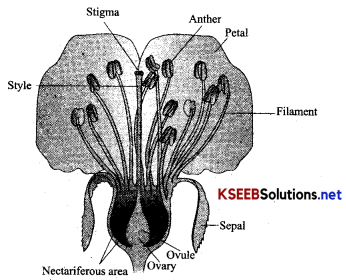
Question 2.
Explain the T. S. of mature anther with neat labelled diagram?
Mention the function of each? (a) Endothecium (b) Middle Layer (c)Tapetum.
Answer:
In transverse section a typical microsporangium is circular in outline, which is surrounded by four wall layers.
(a) Epidermis: Single layer of parenchyma, protective in function. It becomes stretched and shrivel off at
maturity.
(b) Endothecium: Single layered cells, radially elongated, with fibrous thickenings. They remain thin walled in the line of dehiscence (stomium) in between two microsporangia. They help in hygroscopic movement which help in dehiscence.
(c) Middle layers: Three layers of cells generally disintegrate in mature anthers and provide nourishment to sporogenous cells.
(d) Tapetum: It is a layer of nutritive tissue present around microspore mother cell. Each cell has dense cytoplasm, multinucleated due to endomitosis [because karyokinesis does not followed by cytokinesis]
(e) Sporogenous tissues ace a group of compactly arranged homogenous cells, present in the centre of each microsporangium,which diffrentiates into spores.
Question 3.
Define microsporogenesis?
Answer:
It is the process of “formation of microspores from microspore mother cell through meiosis”.
![]()
Question 4.
Explain the process of microspore formation?
Answer:
- The cells of sporogenous tissue become round and loosely arranged cells known as pollen mother cell or microspore mother cell.
- These cells undergo meiosis to form microspores, which are arranged in cluster of four cells, so known as microspore tetrads or pollen tetrads.
- As the anthers mature and dehydrate, pollen tetrads, separate from one another and develop into “pollen grains”. They are released with dehiscence of anther.

Question 5.
Explain the structure of pollen grain? or Briefly explain the structure of pollen grain.
Answer:
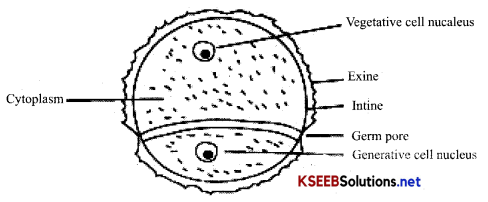
Structure of Mature Pollen Grain
Pollen grain (Microspore): It is a haploid, uninucleate minute spores produced in large numbers as a result of meiosis in microspore mother cell inside the microsporangia.
Structrure: Pollen grains are generally spherical shaped measuring 25 to 50 pm in diameter. The outer layer is made up of two layered walls, outer exine and inner intine.
Exine: It is a hard protective outer layer made up of a highly resistant organic material sporopollenin, which preserve pollen grains as fossils.
It bears spines, ridges and other types of surface outgrowths which are of systemic value. Exine has prominent apertures called germ pores [where exine is thin, the sporopollenin is absent] through which pollen tube emerges out after pollination.
Intine: It is a inner layer made up of cellulose and pectin and has plates of enzymatic proteins in the vicinity of germpores.
Cytoplasm: It is surrounded by plasma membrane and uninucleate (nucleus) which divides mitotically. Matured pollen grain contains two cells, bigger vegetative cell and smaller generative cell.
Vegetative cell or Tube cell: It is larger, remains at the centre and have abundant reserve food and a large irregularly shaped nucleus.
Generative cell: Small and floats in the cytoplasm of vegetative cell. Spindle shape with dense cytoplasm and a. nucleus.

The pollen grains are shed at this two celled stage in 60% of angiosperms. In others 3-celled stage, where generative cell divide by mitosis and give rise to two male gametes.
Question 6.
Draw labelled diagram of pollen grain?
Answer:
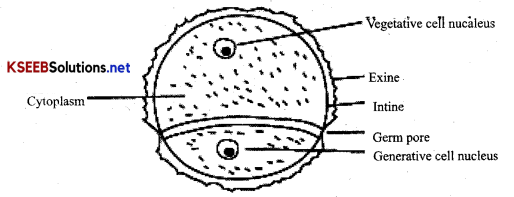
Structure of Mature Pollen Grain
Question 7.
Write importance of pollen grains?
Answer:
Important in life cycle of angiosperms.
- Highly nutritious (certain plants) used as supplements (in the form of tablets and syrups)
- Increases the performance of athletes and racehorses.
- Gauses allergic diseases and respiratory disorders in some people. (Hay fever)
![]()
Question 8.
Write a note on viability of pollen grains?
Answer:
Pollen Viability is defined as the ability to live, germinate when conditions are favourable on the stigmatic surface. It differs from species to species, which depends on temperature and humidity. Ex: Rice and Wheat – viable only for 30 min.
Members of Rosaceae, Leguminosae, Solanaceae are viable for several months.
Question 9.
What is cryopreservation? or How pollen grains are preserved.
Answer:
Cryopreservation: Storing viable pollen grains in liquid Nitrogen (at – 196° C), which can be used as pollen banks in crop breeding programmes.
Question 10.
Explain the structure of Megasporangium or Ovule with labelled diagram? or Describe the .structure of Anatropus Ovule?
Answer:
- Funicle: Stalk of an ovule, which is attached to the placenta.
- Raphe: Long ridge formed by lengthwise fusion of funicle with the body of ovule.
- Hilum: It is a junction between ovule and funicle and even extends to form raphe.
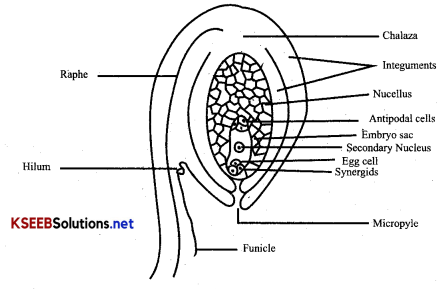
Structure of an Ovule
- Integuments: Multicellular, one or two-layered which surrounds ovule and protective in function.
- Nucellus: These are the cells with abundant reserve food material enclosed with in integuments. It nourishes the developing Embryo cells.
- Micropyle: Ovule is surrounded by integuments except at the tip, resulting in a small opening known as micropyle. Through this pore pollen tube enters into the ovule. ,
- Chalaza: The basal part of an ovule opposite to micropyle, swollen part of the nucellus.
- Embryosac: It is the female gametophyte which contains Egg apparatus, Antipodal cells synergids and secondary nucleus.
Question 11.
Give any one function of the Nucellus in an Ovule? (1M)
Answer:
Nourishes developing embryo cells.
![]()
Question 12.
Explain megasporogenesis? or Write the events of development of female gametophyte incorrect order?
Answer:
The process of formation of megaspore from Megaspore Mother Cell, (MMC), through meiosis is known as megasporogenesis. MMC is large nucleated with dense cytoplasm. It undergoes meiosis, which results in. the production of 4 megaspores. Out of 4, 3 degenerates and one megaspore is functional which developes into female gametophyte. “Method of embryo sac formation from a single megaspore is known as Monosporic type of development”.
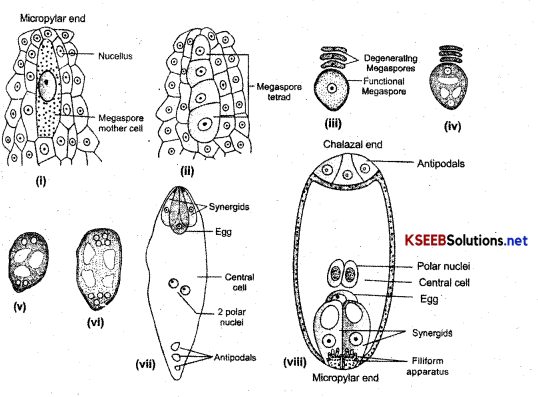
Developments of Female Gametophyte
Megaspore mother cell undergoes 3 successive mitotic divisions to form 8 nucleated embryo sac.
Question 13.
Name the components of egg apparatus in an Embryo sac?
Answer:
The egg cell, Synergids, Antipodals, Polar nuclei
Question 14.
What is monosporic development of female gametophyte?
Answer:
Method of embryo sac formation from a single megaspore.
Question 15.
Name the cells found at the chalazal end of embryo sac?
Answer:
Antipodal cells.
Question 16.
Mention the function of filiform apparatus?
Answer:
Filiform apparatus guides the entry of pollen tube towards Egg cell.
![]()
Question 17.
Name the female gametophyte of Angiosperms?
Answer:
Embryo sac.
Question 18.
How many nuclei and cells are present in female gametophytes?
Answer:
8 Nuclei and 7 cells.
Question 19.
Draw a neat labelled diagram of embryo sac?
Answer:

Question 20.
Define pollination?
Answer:
Pollination is the transfer of pollen grain from the anther to the stigma of a pistil.
Types – depending on the source of pollen 3 types
- Autogamy
- Geitonogamy
- Xenogamy
Question 21.
Define Autogamy?
Answer:
Autogamy (Self-pollination): Transfer of pollen grain from anther to the stigma of the same flower.
Question 22.
What are Chasmogamous flowers? Give examples.
Answer:
Chasmogamous are normal flowers with exposed anthers and stigma which favours cross-pollination.
Ex: Oxalis, Catharanthus
Question 23.
What are Cleistogamous flowers?
Answer:
Cleistogamous are Flowers that do not open at all, which favours self-pollination in the absence of pollinators.
Ex: Oxalis, Commelina.
![]()
Question 24.
Explain the factors which favours self-pollination?
Answer:
- Homogamy – Anthers and stigma of some bisexual flowers mature at same time. It requires synchrony in pollen release and receptivity of stigma and close nearer position of anther and stigma like bending and folding. Ex: Vinca, Potato, Sunflower etc.
- Autogamy
- Cleistogamous flower.
Question 25.
Mention the type of pollination which ensures genetic recombination?
Answer:
Cross-pollination.
Question 26.
What type of pollination is seen in Cleistogamous flowers?
Answer:
Self-pollination.
Question 27.
Explain types of cross-pollination? or What is Xenogamy/Geitonogamy? Give examples.
Answer:
- Geitonogamy: Transfer of pollen grain from tjie anther to the stigma of another flower of the same plant. (It has genetically similar to autogamy). It involves pollinators. Ex: Hibiscus.
- Xenogamy: Transfer of pollen grain from the anther to the stigma of a flower on different plant. (It has genetically variability). Ex: Calotropis, maize, cucurbita etc.
- Agents of Pollination: Cross-pollination involved plants have abiotic ,and biotic agents as pollinators.
Question 28.
What are the characters of wind-pollinated flowers? Give examples.
Answer:
(a) Anemophily: Pollination by wind, most. common amongst abiotic pollinators.
- Characteristics of anemophilous flowers.
- Flowers are small, colourless, odourless, nectarless.
- Flowers are light, non-sticky, winged.
- Weil exposed long stamens, long styles and feathery stigma.
Ex; Tassels of com cob in which have clusters of style and stigma which wave in the wind to trap pollen grain. – Ex: Wheat, Paddy, Grasses.
(b) Hydrophily: Pollination by water: Ex: Monocots, Algae, Bryophytes, Pteridophytes etc.
Question 29.
How is pollination affected in Vallisneria and Zostera? or How does pollination is achieved in Vallisneria and Sea grass.
Answer:
Freshwater hydrophytes like Vallisneria is submerged hydrophyte, Dioecious. Female flowers reach the surface of the water with their long stalk. Pollen grain released on surface of water, which are carried passively by water current.
Marine water Hydrophytejike Zostera (sea grass) have female flower submerged in water and the pollen grains are released inside the water.
Question 30.
Write the characteristic features of water pollinated plant’s, pollen grains?
Answer:
Hydrophytes have pollen grains – needle-like without exine, long, ribbon, like, mucilage covering protects pollen grain.
![]()
Question 31.
Write the characters of entomophilous flowers or insect pollinated flowers?
Answer:
(a) Adaptations of entomophilous flowers pollinated by Bat:
- Large, brightly coloured bracts and with Sticky pollens, rich in nectar and scents.
- Rafflesia: The largest flower produces a foul smell to attract flies and beetles.
- Amorphophallus: Tallest flower, safe place to lay eggs for insects.
- Gestmm Noctorum: Nocturnal flower attracts nocturnal insects by its scent.
(b) Chiropterophily: Pollination by Bat.
Question 32.
List adaptation features of Bat pollinated flowers? Give examples.
Answer:
Large, freely exposed, tough, strong scent, open in the evening or night.
Ex: Kigelia pinnata, Anthocephalus, Adansonia etc.
Question 33.
Explain relationship between yucca and moth?
Answer:
Moth cannot complete its life cycle without Yucca and vice versa. Moth deposits eggs in the locule of the Ovary, larvae come out of eggs as the seeds start developing in turn Yucca flower gets pollinated.
Question 34.
What are pollen robbers?
Answer:
Many insects just consume nectar and pollen without bringing pollination – known as pollen or nectar robbers.
[Note; Omithophily: Pollination by birds
- Flowers attract birds by their colour and nectar.
Ex: Bombax, Butea, Agave. - Malacophily: Pollination by snails and slugs, small shrubs flowers are pollinated.
Ex: Strawberry, Chrysanthemum etc. - Myrmecophily: Pollination by Ants.
- Tree species flowers are pollinated by the activities of ants.
Ex: Mango, Litchi, Acacia, Pongomia etc.]
Question 35.
Differences between self and cross-pollination?
Answer:
| Self Pollination | Cross-Pollination |
| 1. Maintains the purity of race from generation to generation like improved and high yielding character can be maintained. | 1. Brings genetic recombination and produces variation Healthier and stronger offsprings |
| 2. Disadvantage: Lack genetic diversity, lead to degeneration of race i.e. inbreeding depression. |
2. Disadvantage: If unwanted disadvantage characters are introduced it leads to loss of species. |
Question 36.
Mention two strategies evolved to prevent self pollination in flower? or What are outbreeding devices? Mention its significance.
Answer:
Since self pollination results in inbreeding depression, plants have many devices to discourage self pollination and encourage cross pollination.
- Pollen release and stigma receptivity are not synchronised.
Ex: Stigma ripens earlier in wheat and paddy (protogyny). Anthers ripens before stigma (protoandry) in sunflower and .Oeimum. - Production of unisexual flowers Ex: Castor, Maize.
- Anthers and stigma placed at different positions.
- Self-incompatibility and self sterility.
Question 37.
What is self-incompatibility?
Answer:
“The ability of a plant to reject its own pollen and pollens of closely related species” is known as seif incompatibility.
![]()
Question 38.
Write a note on pollen pistil interaction?
Answer:
The pistil (gynoecium ) has the ability to recognise the pollen whether it is of compatible (right type) or incompatible (wrong type) i.e. self-incompatibility.
This recognising capacity is mediated by chemical components of the pollen interacting with of pistil. If poll en grain has allele which matches an allele of stigma then pollen tube fails to grow.
Germination of pollen grain: After compatible pollination, pollen grain,
- Germinates on the stigma to produce pollen tube through one of the germ pores.
- The contents of pollen grain move into pollen tube, which grows through the tissues of stigma, style and reaches the ovary.
- Pollen tube enters the “-ovule through micropyle and enters one of the synergids through filiform apparatus. (which guides the pollen tube to entry towards egg).
All these events are referred to as pollen-pistil interaction.
[This knowledge gained in this area help the plant breeders in manipulating pollen pistil interaction].
Question 39.
Draw a neat labelled diagram to show pollen germination on stigma?
Answer:
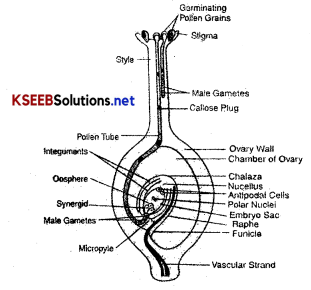
Question 40.
Define Artificial Hybridisation, Emasculation, Bagging? or What is Artificial hybridisation? By which
technique it is achieved.
Answer:
[Hybridisation: Crossing two plants differing from each other genotypically in one or more characters].
Artificial Hybridisation is an approach for crop improvement programme – Crossing two plants, i.e. artificially pollinating female plant with desired pollen grain and female flowers stigma is protected from contamination. This is achieved by techniques – Emasculation and bagging.
Emasculation: Removal of stamens or anthers of a bisexual flower without affecting the female reproductive organs.
Bagging: Covering emasculated flower with a polythene bag immediately to prevent cross-pollination by unwanted pollen.
[During artificial hybridisation when the stigma of bagged flowers attain receptivity mature pollen grain from the anthers are dusted on the stigma, pollinated flowers are rebagged and fruits are allowed to develop.]
Question 41.
How is bagging useful in plant breeding programme?
Answer:
It prevents cross-pollination by unwanted pollen.
![]()
Question 42.
What is meant by Emasculation? When and why does a plant breeder employ this technique. (2M) Ans. Removal of anthers of a bisexual flower is known as emasculation. During performing artificial hybridisation to avoid self pollination .
Question 43.
Define Double fertilisation?
Answer:
Double fertilisation – “is a fertilisation process in flowering plants, in which one of the male gamete fertilises an egg cell to form zygote y/hile (second) the other fuses with two polar nuclei to form endopserm”. [Involves two types of fusions Syngamy + Triple fusion in an embryo sac.]
Question 44.
Explain Double fertilisation? or What is double fertilisation? Describe fertilised Embryo sac with a neat labelled diagram.
Answer:
Pollen tube with male gametes enter into embryo sac through micropyle.
After entering into one of the synergids, pollen tube release two male gametes into the cytoplasm of the synergid.
One of the male gamete moves towards the egg cell and fuses with its nucleus, completing syngamy, which results in formation of diploid zygote.
Other male gamete moves towards the two polar nuclei fuses.with them to produce triploid primary endosperm nucleus.
It involves fusion of three haploid nuclei – Triple fusion. (vegetative fertilisation).
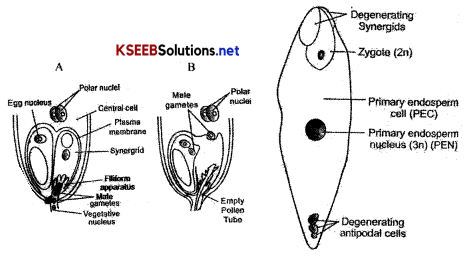
Fertilized Embryo Sac
Question 45.
Give an account of significance of double fertilisation?
Answer:
- Stimulates embryo double fertilisation.
- Zygote maintain constant chromosome number in the life cycle of plant.
- Recombination of genes, leading to new characters in offsprings.
Question 46.
Difference between male gametophyte and female gametophyte?
Answer:
| Male gametophyte | Female gametophyte |
| 1. It is derived from microspores inside another. | 1. It is derived from a megaspore formed inside the ovule. |
| 2. Micropores shed at maturity. | 2. Megaspores do not shed. |
| 3. Male gametes 3 celled | 3. Female gamete – 7 celled. |
![]()
Question 47.
Differentiate between self and cross-pollination.
Answer:
| Self Pollination | Cross-Pollination |
| 1. Pollination in the same flower, or two flowers on the same plant. | 1. Pollination between two flowers on different plants. |
| 2. Monoecious condition. | 2. Dioecious condition. |
| 3. Pollinating agents are not required. | 3. Require pollinating agents. |
| 4. No variation. Ex: Wheat, Rice, Pea, Tomato etc. |
4. Variation produced. Ex: Maize, Coconut, Papaya, Sugar cane etc. |
Question 48.
Define Endosperm?
Answer:
“It is a nutritive tissue which provides essential nutrients to the developing embryo and to young seedlings during germination.”
Question 49.
Explain endosperm formation in Coconut?
Answer:
It develops from the primary endosperm nucleus (PEN) which has undergone vegetative fertilisation.
PEN undergoes first free nuclear division, later on cell wall formation and becomes cellular endosperm.
Ex: Coconut water-free nuclear division.
White kernel – Cellular.
Question 50.
Which cell of fertilised embryo sac forms the kernel of the coconut?
Answer:
An Endosperm cell forms kernel of coconut.
” [Based on the presence or absence (used up).
Endosperm seeds are classified as Endospermous / albuminous – Not completely Consumed endosperm → Monocots seeds. Nonendospermous / Exalbuminous – Completely consumed endosperm → Dicots seeds.]
Question 51.
Define Embryogenesis?
Answer:
Embryogenesis: “ The process of the development of embryo from the zygote”.
Question 52.
Explain Embryogenesis in Dicot along with a neat labelled diagram?
Answer:
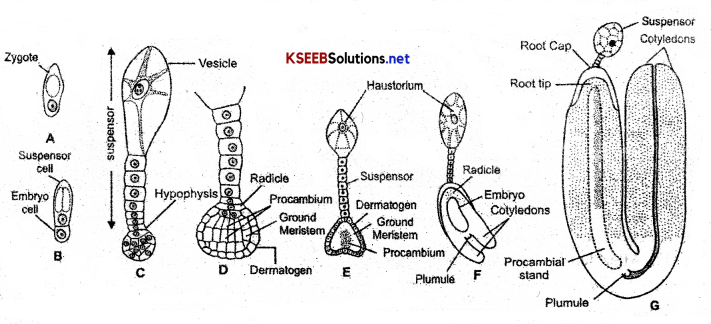
The Embryogeny process are similar in both monocots, and dicots, but in dicots, after globular stage, it ends up with single terminal cotyledon whereas in dicots. 2 cotyledons preceded by heart-shaped embryo formation. Zygotes enlarge in size and divide transversely to form larger basal suspensor cell and smaller terminal embryo cells. The basal cell divides transversely and forms 6-8 suspensor cells, the last cell in hypophysis. The terminal cell divides longitudinally and transversely to form a globular, heart-shaped and mature embryo subsequently.
Question 53.
What is Epicotyl?
Answer:
The portion of the embryonal axis above the level of cotyledons is the Epicotyl, which terminates with plumule.
Question 54.
What is Hypocotyi?
Answer:
The cylindrical portion below the level of cotyledons is the Hypocotyi, terminates with radicle covered with a root cap.
![]()
Question 55.
Draw a neat labelled diagram of dicot embryo.
Answer:
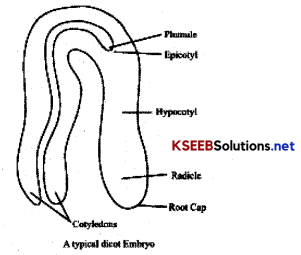
Question 56.
ExplaIn the structure of Monocot Embryo?
Answer:
Monocot embryo has only one cotyledon known as Scutellum. Which is situated towards one side of embryonal axis. The embryonal axis above the level of attachment of scutellum is Epicotyl, which has shoot apex with leal pnrnordia enclosed with Coleoptile.
At its lower end, embryonal axis is Hypocotyl which has radicle and root cap enclosed with Coleorrhiza.

Question 57.
Define Scutellum?
Answer:
Single cotyledon in monocot seed.
Seed: After fertilisation the seed is the final product formed inside fruits, “it is a fertilised ovule”.
[Seeds typically consists of seed coats, cotyledons and an embryo axis].
Question 58.
Explain the structure of Dicot seed?
Answer:
The two integuments of the ovule becomes seed coat, outer leathery testa, and inner thin tegmen.
The micropyle remains as small pore, which helps in entry of O2 and H2O during germination.
Two Cotyledons are large and thick which store food.
One end of embryo axis in between cotyledons is plumule, other end posses Radicle.
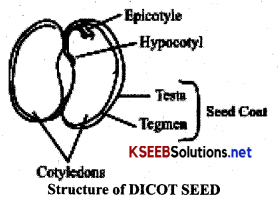
Question 59.
Explain the structure of Monocot seed along with neat labelled diagram?
Answer:
- Single seeded fruit – Caryopsis (Maize).
- Endospermic, so endosperm has protein rich Aleurone layer.
- Single cotyledon known as Scutellum.
- Plumule covered with coleoptile and radicle covered with coleorrhiza.

L. S. of Maize grain (MONOCOT SEED)
![]()
Question 60.
Mention 2 types of Seeds with examples?
Answer:
- Albuminous seeds: with Endosperm. Ex: Wheat, Com etc.
- Exalbuminous seeds: without or (used up) endosperm. Ex: Bean, Pea etc.
Question 61.
Define perisperm give 2 examples.
Answer:
In some seeds nucellus remains even after seed formation, it is called as Perisperm Ex: Black pepper, Nymphea.
Question 62.
What is seed Dormancy?
Answer:
As the seed matures, water content is reduced, embryo slow down its activity, and enter a state of inactivity seed Dormancy, because seeds prefer to germinate under favourable conditions.
Question 63.
Differentiate between True and false fruits?
Answer:
- True fruits: Fruits derived from ovary Ex: Tomato, Grapes, Coconut etc.
- False fruits: Fruits derived from ovary along with accessory floral parts like thalamus. Ex: Apple, Strawberry, Cashew etc.
- Parthenocarpic fruits (Seedless fruits)
Question 64.
What are Parthenocarpic fruits? Give examples.
Answer:
Fruits develop without fertilisation. Ex: Banana, Pineapple, Grapes etc.
[Artificially induced by spraying Auxin, Gibberllin etc.]
Question 65.
What are the advantages of seed?
Answer:
Advantage of seed production in Angiosperms:
- Seeds remain viable for several years.
- Seed coat protects embryo.
- Seedlings are nourished.
- Better adaptive strategies.
- Genetic recombinations leading to Variations.
- Basis of our agriculture – used as food, to raise crop in the next season.
Question 66.
Write a note on Seed Viability?
Answer:
Seed Viability is for several months to years. Oldest seed from Arctic Tundra in Lupinus arcticus plant, germinated after 10,000 years of dormancy.
Recently from Dead sea, in Phoenix dactylifera plant germinated after 2000 years of dormancy.
![]()
Question 67.
What is Apomixis?
Answer:
“Production of seed along with embryo without fertilisation”. (Agamospermy) it is a form of asexual reproduction Ex: Mango, Orange, Brinjal, Grasses etc.
[causes → Diploid egg develop into embryo without reduction division.
→ Embryo sac cells develop into embryo.]
Question 68.
Write a note on Apomixis significance?
Answer:
- Shortens the time required to produce new individuals and genetically controls.
- Assures total transfer of characters to the progeny and maintains hybrid vigour.
- Apomixis gained importance for problems of hybrids.
[Note: Hybrid seeds have to produced every year, if they are sown, genes segregate and do not maintain hybrid characters.
Hybrid seeds are expensive, so if apomictics is preferred there is no separation of characters, so need not to buy new hybrid seeds every years. Research studies are aiming towards transfer of apomictic genes into hybrid varieties.]
Question 69.
Define polyembryoy? Give any 2 examples.
Answer:
Phenomenon of development of more than one embryo in the seed. Ex: Citrus fruits, Mango, Onion etc.
[Causes: Cleavage of zygote into more than one unit, each develops into embryo.
Cells of embryo sac → haploid embryos.
Outside embryo sac cells like nucellus and integuments.]
Question 70.
Write significance of polyembryony?
Answer:
Plant breeding and horticulture.
Haploid embryos are used to raise homozygous diploids. Genetically uniform seedlings in fruit trees.
![]()
Question 71.
Mention any five differences between microsporogenesis and megasporogenesis?
Answer:
| Microsporogenesis | Megasporogenesis |
| 1. It is the formation of microspore from microspore mother cell through meosis. | 1. It is the formation of megaspore from megaspore mother cell through meosis. |
| 2. It results in the formation of four microspores all of which are functional. | 2. It results in the formation of four megaspores out of which three degenerate and only one is functional. |
| 3. The microspore develops wall layers and forms pollen grains. | 3. The single functional megaspore forms embryosac. |
| 4. This occurs in the sporogenous tissue with in the anther. | 4. This occurs in the nucellus which is found with in the ovule. |
| 5. The four microspores are arranged in the form of tetrad. | 5. The four megaspores are arranged in linear form |
→ Flower:
According to biologists, flowers are morphological embryological structures and sites of sexual reproduction. Diversity in their structure is due to range of adaptations ensures sexual reproduction and assures fruits and seeds set.
→ Pre Feitiusation Structures And Events:
Flowers – are modified shoots. Structural and hormonal changes act on vegetative buds, leads to differentiation and development of floral buds.
A flower morphologically ha&4 whorls.
Two accessory whorlš are Calyx and Corolla.
Two essential whorls are Androecium contain male reproductive structure namely Stamens and Gynocicurn containam female reproductive structure namely Carpets.
→ Stamen, Microsoprangium and Pollen Grain:
- Each stamen (microsporophyll) has terminal spore bearing organ the Anther, and the long slender stalk filament.
- Each anther consists of two anther lobes joined together by connective, each anther lobe consists of pollen sacs.
- Each pallen sac contains numerous pollen grains (microspores) and a 4 to 5 layered anther wall.

Stamens showing different parts
→ Structure of Microspohangium/Anther
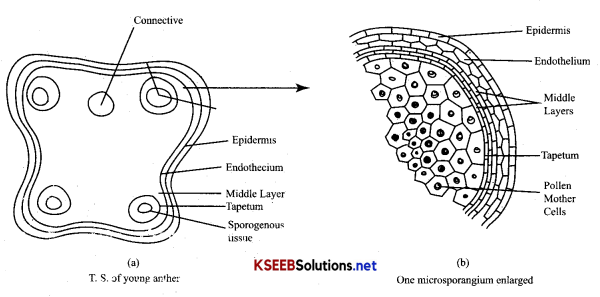
T.S of young anther
![]()
→ The Pistil, Megasporangiúm And Embryo Sac:
The gynoecium or pistil is the female reproductive part of the flower consisting of carpels [Megasporophyll].
- A Pistil with one carpel – Monocarpellary
Ex. Fabaceae - rwt cirpeIs Bicarpellary
Ex. Solanaceae - Three earpcls – Tricarpellary
Ex. Orchidaceae - Five camels – Pentacarpellary
Ex. Cucurbitaceae, - If carpcs fused together – Syncarpous
Ex. Hibiscus, papayer - Carpels free – Apocarpous
Ex. Vinca rosea, champak
→ Each gynoecium has 3 parts
- Stigma,
- Style,
- Ovary.
Stigma: Serves as landing platform for pollen grains vary in shapes. It has sticky surface where pollen grains geminate after pollination.
Style: Elongated, slender part connects stigma with ovary.
Ovary: It is the basal swollen part of pistil, that contains ovules and eggs in its cavity. The placenta a ridgeftissu which is a place for attachment of ovules is located inside the locule.
→ Structure of Embryo Sac:
First the functional megaspore nucleus divides mitoticafly to form 2 nuclei which move towards opposite pole forming 2- Nucleate embryo sac. The developing embryo sac enlarges in size due to formation of vacuole in the centre.
Each 2 nulci, divides and redivides, forming 4 nculei at micropylar end and 4 nuclei at chalazal end, here they under go free nuclear division. At 8 celled stage cell wall formation.
Out of 4 nuclei at micropylar end, 3 differentiate to produce Egg apparatus = 1 Egg + 2 Synergid cells. 4 nuclei at chalazal, 3 remains at, polar region and foi-ni Antipodals.
One nucleus from micropylar end, one from chalazal end migrate towards the centre and fuse to form (2n) diploid secondary nucleus.
Thus a typical angiosperm embryosac at maturity though 8 nucleate, it is 7 celled.
![]()
→ Double Fertilisation:
Nawaschin discovered double fertilisation in Angiosperms. It is the process of forming Zygote and Endosperm.
→ Post Fertilisation Events:
Includes – development of Endosperm, Embryo mattifation of Ovary into fruit. Ovule into seed.
→ Embryo:
After fertilisation the zygote grows and give rise to the embryo. It is a post fertilisation product.
→ Development of Fruits:
The ovary develops into fruit.
The wall of the ovary is the fruit wall known as Pericarp.
Based on the type of pericarp fruits arc classified
(A) (1) Fleshy (Ex: Mango, Orange, Tomato etc.)
(2) Dry (Ex: Groundnut. Mustard etc.)
(B) Based on floral parts involved in fruit formation, classified as true and false fruits.